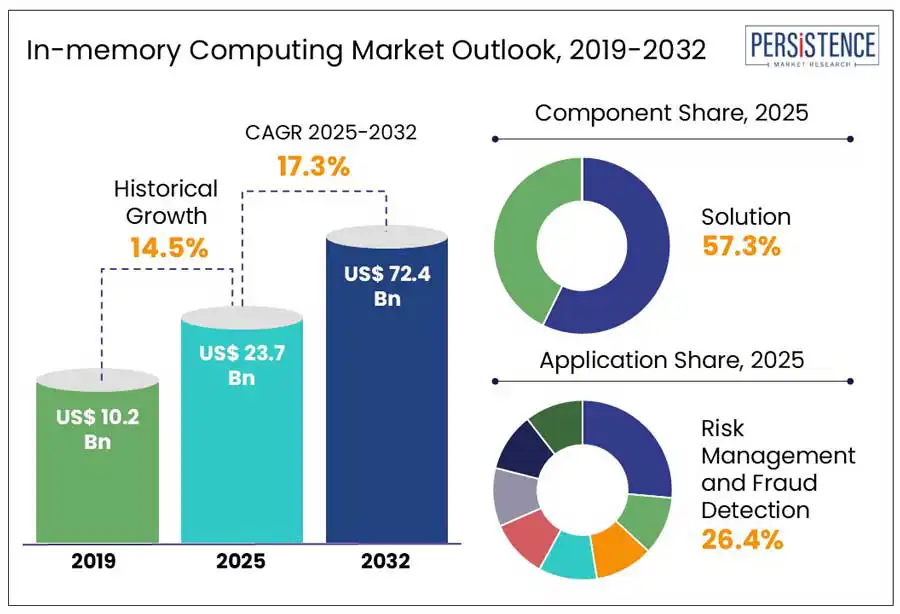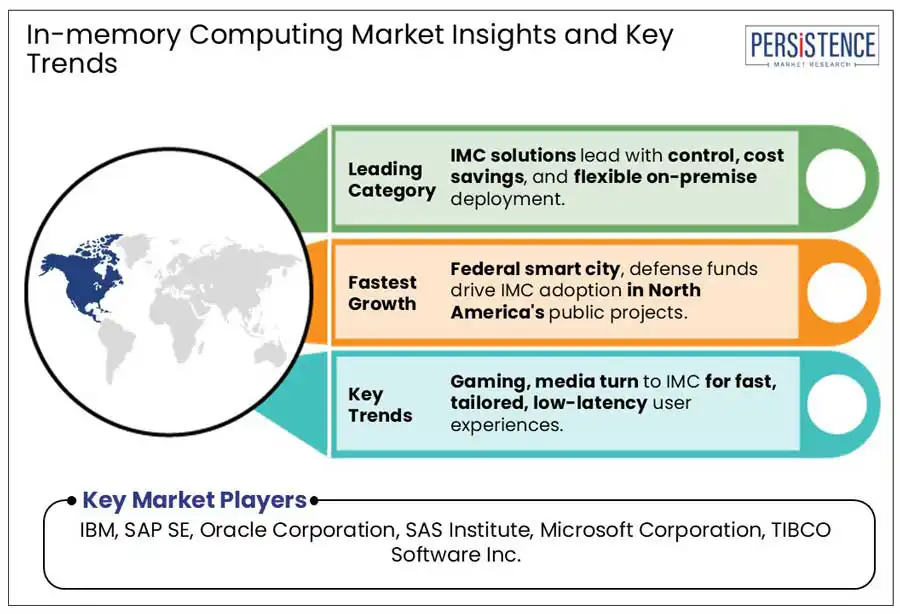ID: PMRREP33026| 130 Pages | 15 Apr 2025 | Format: PDF, Excel, PPT* | IT and Telecommunication

The global in-memory computing market size is projected to rise from US$ 23.7 Bn in 2025 to US$ 72.4 Bn by 2032. It is anticipated to witness a CAGR of 17.3% during the forecast period from 2025 to 2032. The rising transactional and analytical requirements across a wide range of industries worldwide is poised to propel the market. Increasing use of mobile banking and the internet often creates a surging requirement for large data processing, which is anticipated to boost the market. Demand for In-Memory Computing (IMC) is also expected to rise with the implementation of various government initiatives such as the Unique Identification Card (UID), aiming to promote digitization at the national level.

Key Industry Highlights
|
Global Market Attribute |
Key Insights |
|
In-memory Computing Market Size (2025E) |
US$ 23.7 Bn |
|
Market Value Forecast (2032F) |
US$ 72.4 Bn |
|
Projected Growth (CAGR 2025 to 2032) |
17.3% |
|
Historical Market Growth (CAGR 2019 to 2024) |
14.5% |
The global market is projected to surge through 2032 with the ability of IMC to spur digitization initiatives by enabling predictive analytics and hyper-personalization. IMC supports hyper-personalization by allowing systems to process contextual information, transactional history, and behavioral data in real time. Streaming services such as Spotify and Netflix, for example, utilize in-memory data grids to evaluate listening or viewing behavior to adjust recommendations accordingly.
IMC also enhances predictive analytics models by offering computational speed required to utilize machine learning algorithms in real time. Cerner Corporation, a pioneer in healthcare IT, for instance, has been using IMC to provide real-time insights into patient care with the integration of monitoring data, lab results, and Electronic Health Records (EHRs). It enables clinicians to make more informed and faster decisions.
Even though IMC has several benefits, it has a few limitations that are anticipated to hamper demand in the foreseeable future. Compared to conventional storage options such as Solid-State Drives (SSDs) and Hard Disk Drives (HDDs), implementation of large-scale IMC solutions requires significant investments in supporting technologies, memory capacities, and high-performance servers. To configure in-memory platforms including SAP HANA, for example, the requirement of skilled personnel and purpose-built hardware is a must. Hence, companies with limited IT budgets often find it difficult to implement IMC.
Data recovery and persistence is another challenge in the market. There is a high risk of data loss in case of a system crash or power failure as IMC solutions store data in volatile memory. New technologies such as hybrid architecture and persistent memory often combine non-volatile storage with RAM. However, these are still at the nascent stage and require more research work to function well. It is expected to make IMC solutions less reliable in settings where regulatory compliance and data durability are important.
The financial services industry is predicted to create lucrative avenues for IMC solution providers. It is attributed to rising demand for instant decision-making, real-time transaction processing, and speedy analytics. Algorithmic trading will likely be a significant application of IMC in this industry with increasing requirement for machine-based buying and selling decisions in real time.
Renowned companies such as Goldman Sachs and JPMorgan Chase have already implemented IMC frameworks to improve market simulations and trading engines. During market fluctuations, IMC enables the operation of real-time risk models. As per a recent study, more than 80% of equity trades in the U.S. are now algorithmic. This showcases the importance of real-time data processing with IMC.
Increasing integration of IMC into the retail sector is a key trend in the market. IMC solutions are enabling retailers to analyze sales performance, customer behavior, and inventory levels in real time, constantly influencing business decisions. Inditex, the parent company of Zara, for instance, utilizes real-time analytics to modify product placements and store inventory twice a week on the basis of customer feedback and live sales.
Supply chain optimization is another important area that IMC solutions are rapidly transforming. Real-time insight into inventory across various locations can help retailers reduce overstocking and stockouts, which frequently result in revenue loss. For instance, Walmart tracks product flow across more than 4,700 locations using real-time analytics backed by in-memory technologies. It helps enhance the company’s supply chain in response to real-time demand.
By component, the market is bifurcated into solution and service. Among these, the solution segment is expected to dominate by accounting for an in-memory computing market share of nearly 57.3% in 2025. This is primarily due to increasing demand for ready-to-deploy, full-fledged platforms for integration into enterprise IT systems.
Companies are estimated to mainly prefer IMC solutions that blend pre-configured analytics tools, software-defined architecture, and hardware-accelerated memory. These solutions are projected to enable companies to customize, scale, and deploy in-memory capabilities without relying on third-party service providers.
IMC services, on the other hand, are envisioned to see average growth through 2032 as companies adopting these depend on external consultants or managed services for maintenance and deployment. According to a survey, in 2022, more than 62% of companies preferred solution-based models over services for latency-critical, sensitive applications owing to improved customization and efficiency.
Based on application, the market is segregated into risk management and fraud detection, sentiment analysis, geospatial/GIS processing, sales and marketing optimization, predictive analysis, supply chain management, image processing, and route optimization. Out of these, risk management and fraud detection is projected to generate around 26.4% share in 2025, says Persistence Market Research.
Growth is attributed to the ability of IMC to evaluate and process large volumes of datasets in real time. This characteristic likely spurs the adoption among digital payment platforms, insurance companies, and financial institutions who require instant detection of fraud and risks. Transactional data is also analyzed with IMC, allowing for immediate response and detection.
Route optimization is also predicted to be a rapidly growing segment through 2032 due to increasing demand for new systems that can keep up with vast datasets generated by delivery schedules, GPS devices, weather updates, and traffic feeds. IMC can help instantly analyze these inputs, enabling logistics and transportation companies to alter routes on the go.

North America is anticipated to hold a 27.3% share in 2025. It is attributed to increasing investments in real-time analytics and a well-developed enterprise IT landscape. The U.S. in-memory computing market is expected to generate a lion’s share in 2025 as demand for instant insights and data analytics is increasing across various industries.
Healthcare facilities such as Kaiser Permanente and Mayo Clinic in the U.S. are adopting IMC solutions to maintain vast patient datasets for real-time operational forecasting and diagnostics. The defense and government sectors are also showing a keen interest in IMC platforms for initiating strategically essential applications requiring immediate data analysis and zero latency.
Rapid digital transformation across several industries is predicted to create new opportunities in Asia Pacific. China and India are likely to remain at the forefront of growth. In China, IMC platforms are showcasing steady adoption across key companies such as Tencent and Alibaba. They are using these platforms to support large-scale real-time analytics engines for transaction processing, fraud detection, and personalized advertising.
In India, retail, telecom, and banking sectors are exhibiting high adoption of IMC solutions. Banks in the country are constantly integrating these solutions to enhance customer personalization and evaluate real-time credit scoring. Increasing use of Unified Payments Interface (UPI), with more than 100 Bn transactions in 2023 alone, is another key factor estimated to propel demand for secure, ultra-fast data processing infrastructure.
The U.K. is poised to be a hotspot for IMC platform developers and service providers in Europe through 2032. The country’s media and entertainment industry is a recent adopter of IMC solutions to initiate personalized content recommendations. Local streaming services such as ITVX and BBC iPlayer are using IMC to provide personalized viewing suggestions based on regional preferences, device, time of day, and recent user behavior.
In Germany, use of IMC platforms is anticipated to rise in the field of education. The country is planning to boost its digital education scenario, especially under the DigitalPakt Schule initiative with an allocation of €5 Bn. IMC will likely become a key component for the management of vast digital content. Increasing demand for streamlined backend processes such as resource allocation, fee management, student records, and admissions is also likely to create opportunities.
The global in-memory computing market is highly competitive with the presence of various well-established companies. They are focusing on developing new solutions and services by integrating innovative technologies.
A few companies are embracing strategies such as collaborations, partnerships, and mergers and acquisitions to gain a competitive advantage. The market will likely see the entry of several start-ups focusing on gaining funds to accelerate product development.
The global market is projected to be valued at US$ 23.7 Bn in 2025.
Increasing demand for real-time transaction processing across banks and the requirement for supply chain optimization in logistics firms are the key market drivers.
The market is poised to witness a CAGR of 17.3% from 2025 to 2032.
Adoption of IMC platforms in the retail sector and rising demand for personalized content recommendations among streaming service providers are the key market opportunities.
IBM, SAP SE, and Oracle Corporation are a few key players.
|
Report Attribute |
Details |
|
Historical Data/Actuals |
2019 - 2024 |
|
Forecast Period |
2025 - 2032 |
|
Market Analysis Units |
Value: US$ Bn/Mn, Volume: As Applicable |
|
Geographical Coverage |
|
|
Segmental Coverage |
|
|
Competitive Analysis |
|
|
Report Highlights |
|
|
Customization and Pricing |
Available upon request |
By Component
By Application
By Deployment
By Vertical
By Region
Delivery Timelines
For more information on this report and its delivery timelines please get in touch with our sales team.
About Author